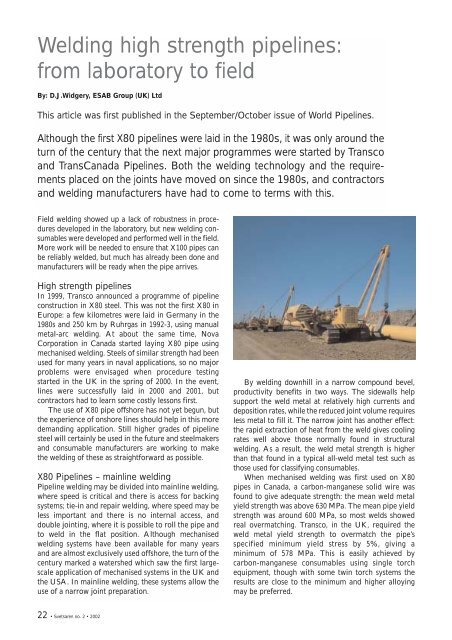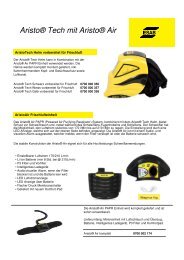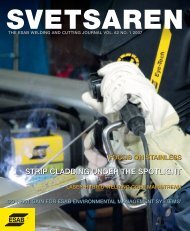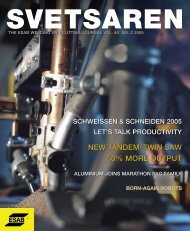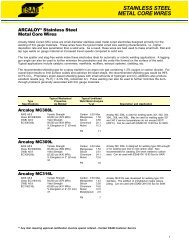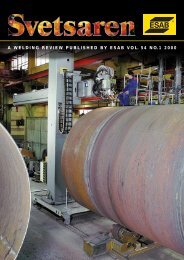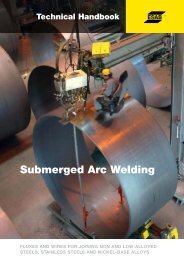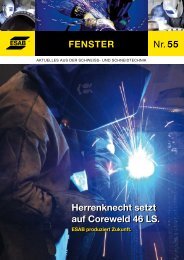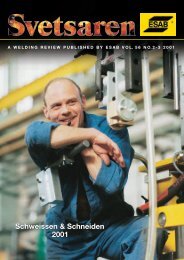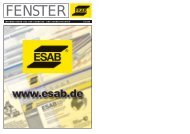Svetsaren_nr2 definitief (Page 1) - Esab
Svetsaren_nr2 definitief (Page 1) - Esab
Svetsaren_nr2 definitief (Page 1) - Esab
You also want an ePaper? Increase the reach of your titles
YUMPU automatically turns print PDFs into web optimized ePapers that Google loves.
Welding high strength pipelines:<br />
from laboratory to field<br />
By: D.J.Widgery, ESAB Group (UK) Ltd<br />
This article was first published in the September/October issue of World Pipelines.<br />
Although the first X80 pipelines were laid in the 1980s, it was only around the<br />
turn of the century that the next major programmes were started by Transco<br />
and TransCanada Pipelines. Both the welding technology and the requirements<br />
placed on the joints have moved on since the 1980s, and contractors<br />
and welding manufacturers have had to come to terms with this.<br />
Field welding showed up a lack of robustness in procedures<br />
developed in the laboratory, but new welding consumables<br />
were developed and performed well in the field.<br />
More work will be needed to ensure that X100 pipes can<br />
be reliably welded, but much has already been done and<br />
manufacturers will be ready when the pipe arrives.<br />
High strength pipelines<br />
In 1999, Transco announced a programme of pipeline<br />
construction in X80 steel. This was not the first X80 in<br />
Europe: a few kilometres were laid in Germany in the<br />
1980s and 250 km by Ruhrgas in 1992-3, using manual<br />
metal-arc welding. At about the same time, Nova<br />
Corporation in Canada started laying X80 pipe using<br />
mechanised welding. Steels of similar strength had been<br />
used for many years in naval applications, so no major<br />
problems were envisaged when procedure testing<br />
started in the UK in the spring of 2000. In the event,<br />
lines were successfully laid in 2000 and 2001, but<br />
contractors had to learn some costly lessons first.<br />
The use of X80 pipe offshore has not yet begun, but<br />
the experience of onshore lines should help in this more<br />
demanding application. Still higher grades of pipeline<br />
steel will certainly be used in the future and steelmakers<br />
and consumable manufacturers are working to make<br />
the welding of these as straightforward as possible.<br />
X80 Pipelines – mainline welding<br />
Pipeline welding may be divided into mainline welding,<br />
where speed is critical and there is access for backing<br />
systems; tie-in and repair welding, where speed may be<br />
less important and there is no internal access, and<br />
double jointing, where it is possible to roll the pipe and<br />
to weld in the flat position. Although mechanised<br />
welding systems have been available for many years<br />
and are almost exclusively used offshore, the turn of the<br />
century marked a watershed which saw the first largescale<br />
application of mechanised systems in the UK and<br />
the USA. In mainline welding, these systems allow the<br />
use of a narrow joint preparation.<br />
By welding downhill in a narrow compound bevel,<br />
productivity benefits in two ways. The sidewalls help<br />
support the weld metal at relatively high currents and<br />
deposition rates, while the reduced joint volume requires<br />
less metal to fill it. The narrow joint has another effect:<br />
the rapid extraction of heat from the weld gives cooling<br />
rates well above those normally found in structural<br />
welding. As a result, the weld metal strength is higher<br />
than that found in a typical all-weld metal test such as<br />
those used for classifying consumables.<br />
When mechanised welding was first used on X80<br />
pipes in Canada, a carbon-manganese solid wire was<br />
found to give adequate strength: the mean weld metal<br />
yield strength was above 630 MPa. The mean pipe yield<br />
strength was around 600 MPa, so most welds showed<br />
real overmatching. Transco, in the UK, required the<br />
weld metal yield strength to overmatch the pipe’s<br />
specified minimum yield stress by 5%, giving a<br />
minimum of 578 MPa. This is easily achieved by<br />
carbon-manganese consumables using single torch<br />
equipment, though with some twin torch systems the<br />
results are close to the minimum and higher alloying<br />
may be preferred.<br />
22 • <strong>Svetsaren</strong> no. 2 • 2002


